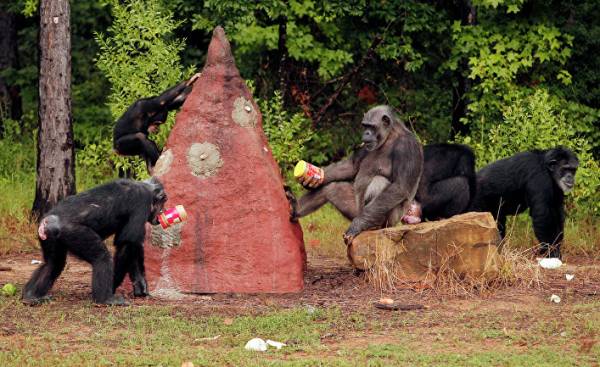
In July, movie fans flocked to cinemas to the film “planet of the apes: War” in which the army modified retrovirus apes waging war against humanity. Chimpanzee riding on horses, gorillas with machine guns, scientists, and orangutans — all this, of course, well suited for the show. But can there ever be something like this happen in real life?
In the novel by Pierre Boulle planet of the apes (1963), which served as the basis for this film, the astronaut Ulysses Measure stuck on a scary planet: it is controlled gorillas, orangutans and chimpanzees, copying the language, culture and technology of their former owners — the people. Meanwhile, the people degenerated into brutal, primitive savages.
In the grim realism of “Planet of the apes”, much due to the amazing attention of the bull to scientific detail and his knowledge of works on animal behavior published by that time. His book is based on the still popular idea that some animals, such as chimpanzees and dolphins, have developed, but the secret communications system that people absolutely are not able to understand. Many prefer to think that all those “arrogant” scientists who assert that animals do not speak, simply is not able to decode the signals of animals.
But the book of bull is undoubtedly the fruit of fiction, because here on Earth, monkeys could never really assimilate human culture exclusively through its imitation. In reality, for a complex culture requires a basic biological abilities that are developed during a long process of evolution. Chimpanzees simply do not have the voice control and the physiology needed to talk.
Also, modern apes, it is impossible to make highly intelligent even with expanding brain capacity of drugs. Although microbes are able to change behavior (for example, the rabies virus makes the behavior of their hosts aggressive), they can’t give animals the ability to speak.
We know this because communication between animals have been actively studied for over a century, and because scientific experiments do not give even a hint on the really complex communication abilities in animals. For example, in the 1940s, scientists decided to bring home a chimpanzee named Vicki. But Viki learned only four words — “Mama”, “Papa”, “cup” (Cup) and “up” (up). It was more than in the previous experiment, when the chimp grew up with a human baby. This experience had to stop after the chimps were unable to learn a single word, but the child began to imitate a chimpanzee.
In the following decades a lot more enthusiasm experiences with teaching apes sign language. However, virtually all linguists agree that the monkeys in these experiments did not demonstrate knowledge of the language. They could remember the meaning of signs, but could not learn grammar rules.
Says a lot about the fact that the statements “talking” monkeys turned out to be extremely self-centered. When monkeys have the means to conduct conversation, their communications are limited to the expression of desires, for example, “give food.” The longest recorded statement of the “talking” APE chimp named Him Chimpski — was: “Give orange me give eat orange me eat orange give me eat orange give me you.” It turned out that chimpanzees, bonobos and gorillas are not the most interesting interlocutors.
On the contrary, after only a few months after pronouncing the first word of a two-year children are able to build a complex, grammatically correct and varied in the topics of sentences consisting of verbs, nouns, prepositions and definitions. They can do this because the human brain evolved to understand and reproduce it.
Many scientists believe that it was born from the use of the marks with different values. Our ancestors were immersed in a world rich in characters, and this has led to an evolutionary response that contributed to the development of neural structures that allow us to effectively manipulate the symbols. The syntax in human language is made possible today because our ancestors for a long time used the symbolic proto-languages. Genes and culture evolved together, reorganizing the human brain.
All this equally applies to military Affairs, which is not only aggression on a large scale. During the war complex human institutions dictate a strict code of conduct and individual roles that help cooperation. According to studies, this level of cooperation may not appear in animals that have no complex culture and characteristics such as, for example, institualisation the socially sanctioned punishment and retribution.
Many of these rules are not obvious and so they need to inculcate, as a rule, during adolescence. But even when it comes to monkeys, who are skilful imitators, we have no conclusive evidence that they actively teach the behavior. If apes cooperate, it’s usually to help relatives. Meanwhile, the scale of human cooperation, which involved a huge number of unrelated people willing to work together is unprecedented, because this cooperation is based on socially learned and transmitted norms.
Now there is already ample evidence that the cultural activities of our ancestors changed the human brain by natural selection, which then continued to expand our cultural ability even more in repeated cycles. For example, in the early Neolithic age people started drinking milk, after which they were subjected to powerful selection, which has won the genes that can break down energy-rich lactose. Such genetically-cultural somelse explains why many of us having ancestors pastoralists, do not suffer from intolerance to lactose.
Not surprisingly, the bull made such a strong emphasis on simulation. The people are descendants of a long line of imitators who copied the reaction of fear from each other to detect predators and avoid danger. Today, this ability manifests itself in empathy and other forms of emotional empathy, which the movie invokes so many feelings. Without these abilities we all watched the movies as sociopaths, and are equally indifferent to the killing and kissing.
Thanks to the imitation of our ancestors learned to cut meat, light a fire, to make digging tools, spears and fishing hooks. These and countless other skills made us perfectly adapted to understanding the movements of others and to reproduce these movements of our muscles, tendons and joints. Eons passed, and today the movie stars demonstrate the same abilities, mimicking the movements of other primates, with precision, which are inaccessible for other species.
Human culture evolved over the millennia, is not something that other species can easily adopt. We can be absolutely sure that no war between the two primates on Earth will be. So it began, other species have to go through such a long process of evolution. And the only monkey that is real war on this planet seems to be ready to do everything to avoid this.







